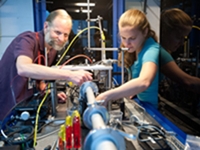Stanford-SLAC team uses X-ray imaging to observe running batteries in real time
24 Jul 2012
By Mark Shwartz
Most electric cars, from the Tesla Model S to the Nissan Leaf, run on rechargeable lithium-ion batteries – a pricey technology that accounts for more than half of the vehicle's total cost. One promising alternative is the lithium-sulphur battery, which can theoretically store five times more energy at a much lower cost.
 But lithium-sulphur technology has a major drawback: After a few dozen cycles of charging and discharging, the battery stops working.
But lithium-sulphur technology has a major drawback: After a few dozen cycles of charging and discharging, the battery stops working.
"The cycle life of lithium-sulphur batteries is very short," said Johanna Nelson, a postdoctoral scholar at the SLAC National Accelerator Laboratory at Stanford University. "Typically, after a few tens of cycles the battery will die, so it isn't viable for electric vehicles, which require many thousands of cycles over a 10- or 20-year lifetime."
A typical lithium-sulphur battery consists of two electrodes – a lithium metal anode and a sulfur-carbon cathode – surrounded by a conductive fluid, or electrolyte. Several studies have attributed the battery's short cycle life to chemical reactions that deplete the cathode of sulfur.
But a recent study by Nelson and her colleagues is raising doubts about the validity of previous experiments. Using high-power X-ray imaging of an actual working battery, the Stanford-SLAC team discovered that sulphur particles in the cathode largely remain intact during discharge.